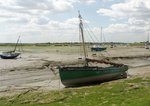Glider
Captain
You will know of the small boats that went to Dunkirk to help with the evacuation. What some of you may not understand, is just how small, some of the small boats were.
The photo shows one of the original boats which made that voyage. She is a 34 ft cockle boat one of a number that went from a village called Leigh on Sea. One of these boats the Renown, was destroyed during the evacuation with the loss of all on board.
I am sure you will agree that to go into a war zone in a boat like this, takes a special kind of courage
The photo shows one of the original boats which made that voyage. She is a 34 ft cockle boat one of a number that went from a village called Leigh on Sea. One of these boats the Renown, was destroyed during the evacuation with the loss of all on board.
I am sure you will agree that to go into a war zone in a boat like this, takes a special kind of courage


 is in order to those involved.
is in order to those involved.